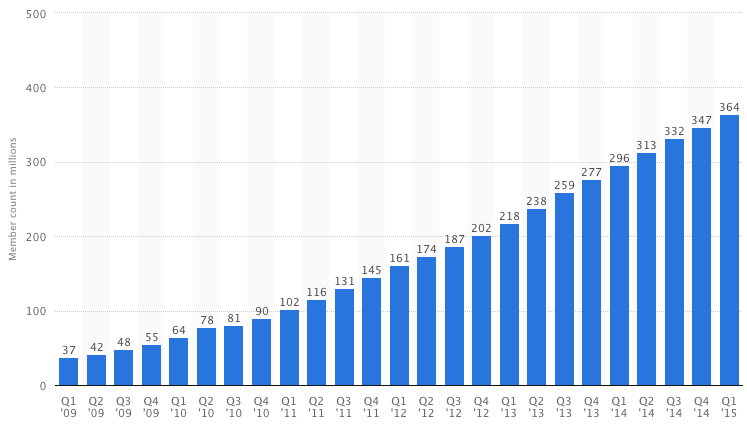Whenever someone asks me what my favorite social network is, they are often baffled by my response. I love LinkedIn and I’m not afraid to let the world know. Sure, there are large parts of the platform that are underdeveloped and in need of some TLC, but the real value of LinkedIn comes from the user community. Having grown from just 37 million members in Q1 of 2009 to over 364 million in Q1 of 2015, there is no better social network for engaging with business-to-business (B2B) prospects than LinkedIn. Not sure if your prospective customers are on there? Use this handy tool to get a glimpse of your potential audience.

There are over 364 million users on LinkedIn, making it the 2nd largest social network in North America!
Sadly, the stigma still exists for many that LinkedIn is exclusively a job-seeking platform, which I believe is fundamentally incorrect. While historically LinkedIn may have attracted exclusively millennial job seekers – it’s many of those very millennials who are now doing research for B2B organizations. In fact, according to a recent Google study in 2014, 46% of all B2B researchers were millennials, up from just 27% only 2 years before in 2012.
If you’ve read any reports on the B2B buyer’s journey in the past few years, you’ll know we are living in the age of the informed buyer. We know prospects do their research before they engage with sales, but where are they doing it? Your website? Social media? Review websites? A recent study from Nielsen suggested only 69% of buyers trust information on a brand website, whereas 84% trust recommendations from people they know. Where do people they know exist? Social media! In particular – LinkedIn. By sharing content on LinkedIn, you have the opportunity to receive implicit support from those who like, comment on, or share your content. Why is this so powerful? The LinkedIn algorithm will syndicate content that has been engaged with by an individual to their connections, allowing your message to reach new audiences. This implicit endorsement is huge for gaining awareness & building trust with prospective buyers. However, this isn’t exclusive to LinkedIn, and in fact this factor is present across most social networks. So what makes LinkedIn special? Aside from the unmatched longevity content seems to enjoy compared to other social platforms, LinkedIn audiences have 2 unique & exclusive traits:
- They share their entire professional history: Unlike any other network, people actively choose to include a rich history of their employment, education & professional interests. This ultimately allows you to align closely with the needs of your target audience when sharing content.
- They have an active mindset dedicated to professional betterment: Rather than passively scrolling through a newsfeed like many Facebook or Twitter users will, LinkedIn users are a lot more in tune with using the site for professional purposes. HubSpot has an excellent infographic discussing the key differences between personal & professional networks.
With these factors in mind, sponsored updates provide an unparalleled opportunity to reach & inform prospective buyers with educational content. If you’ve never set up a sponsored update campaign within LinkedIn, Kissmetrics published an excellent overview (with screenshots!) to help guide you through the process. If you have tried using LinkedIn sponsored updates before and didn’t see success, I encourage you try again. The most common problem I see is a lack of granularity with targeting. As a general rule, the wider an audience you target, the harder it will be to find common content for them to engage with. Instead of taking a one-size-fits all approach, focus on one-size-fits one.
I hope by now you’ve seen the value of sponsored updates on LinkedIn and are ready to dive on in. Before you do though, here are my top tips for success:
- Know Your Audience: Do you have personas built out for your prospective customers? This is more than simply knowing their industry or job role, you should know who they are & what motivates them to take action. If you haven’t already defined your target personas, here is a great guide from Buffer to get you started.
- Provide Real Value: Ask yourself if what you’re offering will actually have a positive impact on those who engage. Seek first to educate, then to convert. By focusing on education, you’ll align more with prospects immediate concerns and build trust.
- Be Engaging & Avoid Sounding Like A Salesperson: Remember this is a targeted campaign on a social network, not search. The only intent signals you have are inferred so you’ll want to avoid hard selling and, instead, focus on problem solving.
- Targeting: This single factor can ultimately make or break your campaign. Do your research, find groups where your target audiences are active and listen to conversations. Understand who makes decisions, and why. Focus on granularity and build up as appropriate. SproutSocial have some excellent resources related to determining your target audience.
- Tracking In Google Analytics: Unlike other major social networks, LinkedIn doesn’t offer any kind of conversion tracking code – ultimately making it difficult to show ROI. Never fear, it’s easy to set up appropriate tracking within Google Analytics, as this handy guide from Kissmetrics shows.
While LinkedIn presents a challenge, it is one well worth overcoming. Sure there are parts of the platform that need to improve, like conversion tracking, but the depth of targeting in combination with the mindset of the audience present new opportunities for B2B marketers. If you’re not sure if your target customers are there, find out! (It’s free!)
If your organization is looking to put together an amazing LinkedIn campaign or find ways social media can help drive the acquisition of new clients, then schedule a time to speak with one of our friendly team members!